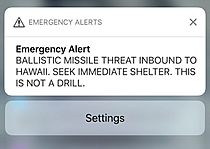2018 Hawaii false missile alert facts for kids
On January 13, 2018, something surprising happened in Hawaii. People received a scary message on their TVs, radios, and cellphones. It said a ballistic missile was coming towards Hawaii! The message told everyone to find shelter and clearly stated, "this is not a drill."
This alert was sent out at 8:07 a.m. Hawaii time. For 38 minutes, people were very worried. Then, another message arrived, saying the first one was a "false alarm." Officials later explained that someone accidentally pushed the wrong button. This happened during a shift change at the Hawaii Emergency Management Agency, which is in charge of emergency alerts.
Hawaii's Governor, David Ige, quickly said he was sorry for the mistake. Two important groups, the U.S. Federal Communications Commission and the Hawaii House of Representatives, started looking into how this error happened.
Contents
What Happened During the Alert?
On that Saturday morning, people across Hawaii suddenly got an urgent message. It was sent through the Emergency Alert System and the Commercial Mobile Alert System. These systems are designed to warn people about real dangers. The message warned of an incoming missile. It also told people to seek shelter right away. The words "this is not a drill" made the message feel very real and serious.
The Mistake and Correction
The first alert was sent out at 8:07 a.m. HST. For over half an hour, many people believed Hawaii was under attack. They quickly tried to find safe places. Some families even hid in bathtubs or garages. About 38 minutes later, a second message was finally sent. This message told everyone that the first alert was a mistake. It said there was no missile threat.
Why Did This Happen?
Officials later explained that the false alert was caused by a human error. An employee at the Hawaii Emergency Management Agency was doing a shift change. During a test of the alert system, they accidentally selected the real alert option instead of the test option. This single mistake sent a terrifying message to everyone in Hawaii.
After the False Alarm
After the mistake was corrected, many people were upset and confused. Governor David Ige quickly apologized to the public. He said the state would work to make sure this kind of error never happens again.
Investigations Begin
Two important groups started looking into the incident. The U.S. Federal Communications Commission (FCC) is a government agency that oversees communication systems. They wanted to understand how the alert system failed. The Hawaii House of Representatives also began its own investigation. They wanted to find out what went wrong and how to prevent it in the future. These investigations aimed to improve safety and make sure emergency alerts are always accurate.
Images for kids
-
David Ige, who served as Governor of Hawaii at the time of the incident
-
Former U.S. Army Brig. Gen. Bruce E. Oliveira (left) was tasked by the State of Hawaii to lead an internal investigation into the incident.




